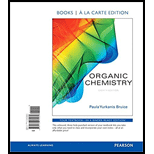
Concept explainers
(a)
Interpretation:
It should be drawn the probable product that would be obtained by the incorrect movement of electron indicated by curved arrows and the wrong in the obtained product’s structure also should be explained.
Concept introduction:
Mechanism of the reaction is the step-by-step description of the process by which reactants are changed into products.
Curved arrows show the bonds that are formed and the bonds that are broken in a reaction.
Curved arrows used to understand a reaction mechanism.
Curved arrows are drawn to show how the electrons move as new covalent bonds are formed existing covalent bonds are broken.
Each arrow represents the simultaneous movement of two electrons from a nucleophile towards an electrophile.
The tail of the arrow is positioned where the electrons are in the reactant; the tail always start at a lone pair of electron or at a bond.
The head of the arrow points to where these same electrons end up in the product; the arrow always points at an atom or a bond.
(b)
Interpretation:
It should be drawn the probable product that would be obtained by the incorrect movement of electron indicated by curved arrows and the wrong in the obtained product’s structure also should be explained.
Concept introduction:
Mechanism of the reaction is the step-by-step description of the process by which reactants are changed into products.
Curved arrows show the bonds that are formed and the bonds that are broken in a reaction.
Curved arrows used to understand a reaction mechanism.
Curved arrows are drawn to show how the electrons move as new covalent bonds are formed existing covalent bonds are broken.
Each arrow represents the simultaneous movement of two electrons from a nucleophile towards an electrophile.
The tail of the arrow is positioned where the electrons are in the reactant; the tail always starts at a lone pair of electron or at a bond.
The head of the arrow points to where these same electrons end up in the product; the arrow always points at an atom or a bond.
(c)
Interpretation:
It should be drawn the probable product that would be obtained by the incorrect movement of electron indicated by curved arrows, and the wrong in the obtained product’s structure also should be explained.
Concept introduction:
Mechanism of the reaction is the step-by-step description of the process by which reactants are changed into products.
Curved arrows show the bonds that are formed and the bonds that are broken in a reaction.
Curved arrows used to understand a reaction mechanism.
Curved arrows are drawn to show how the electrons move as new covalent bonds are formed existing covalent bonds are broken.
Each arrow represents the simultaneous movement of two electrons from a nucleophile towards an electrophile.
The tail of the arrow is positioned where the electrons are in the reactant; the tail always starts at a lone pair of electron or at a bond.
The head of the arrow points to where these same electrons end up in the product; the arrow always points at an atom or a bond.
(d)
Interpretation: It should be drawn the probable product that would be obtained by the incorrect movement of electron indicated by curved arrows. And the wrong in the obtained product’s structure also should be explained.
Concept introduction:
Mechanism of the reaction is the step-by-step description of the process by which reactants are changed into products.
Curved arrows show the bonds that are formed and the bonds that are broken in a reaction.
Curved arrows used to understand a reaction mechanism.
Curved arrows are drawn to show how the electrons move as new covalent bonds are formed existing covalent bonds are broken.
Each arrow represents the simultaneous movement of two electrons from a nucleophile towards an electrophile.
The tail of the arrow is positioned where the electrons are in the reactant; the tail always starts at a lone pair of electron or at a bond.
The head of the arrow points to where these same electrons end up in the product; the arrow always points at an atom or a bond.
Trending nowThis is a popular solution!

Chapter 5 Solutions
ORGANIC CHEMISTRY (LL)-W/MOD.MASTERING.
- Write the products for 3 out of 4 of the following reactionsarrow_forwardWhat structure would turn the starting material into the product and what steps would you take to create the product?arrow_forwardWrite the product of the following sequence of reaction . how the combined reactions allow you to “navigate” between the different functional groupsarrow_forward
- What is the product of each of the following reactions? complete both parts A and B.arrow_forwardwhat are the products of these reactions, be mindful of which was the arrow is pointingarrow_forwardDraw the structure of the major product that would be obtained from the dehydration of 3,5-dimethylcyclohexanol and explainarrow_forward
 EBK A SMALL SCALE APPROACH TO ORGANIC LChemistryISBN:9781305446021Author:LampmanPublisher:CENGAGE LEARNING - CONSIGNMENT
EBK A SMALL SCALE APPROACH TO ORGANIC LChemistryISBN:9781305446021Author:LampmanPublisher:CENGAGE LEARNING - CONSIGNMENT
